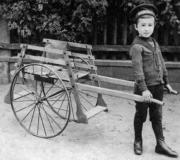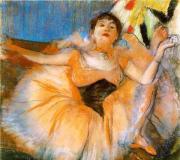Porter in the theater. What are the rows in the theater called - from the first seats - to the very top balcony? Theater row names
Choose best places to the concert, theatrical production, a musical or an opera without knowing the hall in advance is not so easy, since the halls can vary quite a lot. But several general rules It is still possible to formulate. First you need to imagine the layout of the hall. The hall has several zones that are clearly separated from each other. Maximum amount There are five zones in the largest theater: , , , and .
Parterre
Zone auditorium, located closest to the stage, usually below its level. It is generally believed that tickets in the first row of the stalls are the most expensive and the most good places. But this is not always the case, since the most expensive seats are in the box. And the position below the stage is not always convenient, especially if the orchestra pit and the stage are separated. Especially if it's a concert classical music where there is no need to observe what is happening in detail. But one-man performances and monologue performances are more convenient to watch from the stalls and the closer, the better in order to become an accomplice in the theatrical action.
Amphitheater
The spectator area is behind the stalls, separated from it by a passage. It can be located slightly above the ground and rise with ledges. Literally translated, an amphitheater is around a theater. Due to the fact that it is at stage level and above, the viewer receives great review and audibility, and perhaps it is universal in comfort, especially in its first rows. Ballet and performances with a large number characters It's best to look away from the stage so you can see all the action at once.
Mezzanine
Literally translated from French - a beautiful floor. In architecture, the second floor after the ground floor, on which the front, largest and most beautiful rooms were located. And this floor was truly decorated the best, it was the most beautiful. The mezzanine in a theater is a tier above the stalls, usually above the amphitheater.
Balcony
Tier above the mezzanine. As a rule, seats on the balcony and mezzanine are located at a sufficient distance from the stage, so they are more suitable for listening to operas, operettas and musicals (due to their elevation).
Lodges
Separate parts of the hall located on the sides of the stalls, behind it and on the tiers (at the mezzanine level). This is an individual room for several people with a separate entrance. Some even have a small hallway, an antechamber. Traditionally the most expensive and most comfortable places in the hall. They have the opportunity to both be invisible to other viewers and, on the contrary, attract increased attention. They differ in tiers, the first, most prestigious tier, located at the level (or slightly above) of the stalls are called benoir boxes (after the name of this lower tier lie). The lodges located above do not have a special name.
We are accustomed to referring to the classic statement, which says: “The theater begins with a hanger,” although many believe that the most important thing in the temple of Melpomene is the auditorium. After all, the location of the seats plays a key role in whether a particular person will benefit from watching the performance, or whether he will never be able to really see or hear anything. Therefore, in order to avoid incidents, spoiled mood and disappointments, before purchasing tickets, you need to clearly determine where the best seats are in the theater. Of course, the most successful options will cost a lot of money, but a compromise solution can always be found. You just need to take into account a few factors that can simplify the task. We'll talk more about this later.
Comfort was not always valued
The people constantly demand spectacles, emotions and celebration. At all times, it was the theater that gave him such an opportunity. After all, here you can enjoy the acting, admire the action that unfolds on the stage, and mentally immerse yourself in a world where reality is intertwined with fiction. But being a spectator was not always as comfortable as it is today. This was not given special significance, and the main factor was the event itself. Fans of the street arenas of the Middle Ages could watch what was happening only by standing in front of the stage (in the stalls) or from the height of their balcony.
These same names found application with the advent of dramatic halls with a roof and walls, and others were added to them - amphitheater, mezzanine, boxes. Comfort has become a priority, so for modern art connoisseurs, the question of which seats are the best in the theater remains the main one when planning their next appearance. Let's try to understand this interesting question.
If you are a beginner and are not familiar with the features and layout of auditoriums, without which it is impossible to find the best seats in the theater, do not be discouraged - this obstacle is easily removable. First, take into account that all arenas in the world have certain similarities. Russia is no exception, where buildings were erected according to approximately the same plan, differing only architectural styles, which depended on the specifics of the troupe’s work.
The first thing you should pay attention to when choosing a landing zone is its functionality. Secondly, what type of performance do you prefer (musical, drama, ballet, opera, concert). And third - your personal characteristics, state of vision and hearing.

Simply put, you can secure the best seats in the theater by establishing the advantage of a separate viewing area for viewing a specific production, taking into account your own individuality. Based on this, we offer you some practical advice.
Emphasis on the location of spectator areas
There are people who, in principle, do not care where to sit, but if you are not one of them, try to remember the following: all seating areas are clearly separated, their number, if the theater is large, reaches five:
- stalls;
- amphitheater;
- mezzanine;
- balconies;
- lodge.
Each of them has its own advantages and specifics, which we will now consider, and then draw a conclusion about where the best seats are in the theater.
Parterre is the area located directly in front of the stage, fairly close to it, but at a lower level. Many are convinced that the first rows are the most prestigious and have a very good location. But this is not entirely true, since, being below the stage, it is inconvenient to observe what is happening, especially when the orchestra pit is located in front. But if you want to feel like a participant in the performance, the stalls in this regard will be the ideal place.
Amphitheater (in literal translation“around the theater”) - an area located behind the stalls and separated from it by a passage. It can be raised slightly to stage level for excellent visibility and sound. Therefore, in terms of comfort, the amphitheater is universal. It is suitable for both ballet connoisseurs and supporters of large-scale performances in terms of the number of characters.
The mezzanine (translated as “beautiful floor”) is the tier located above the amphitheater, well suited for fans of musicals, opera or operetta, as excellent audibility is guaranteed here. But in order to get a good look at the dramatic production, you will have to get binoculars.
Binoculars will also come in handy when purchasing tickets for the balcony, which occupies a position above the mezzanine.
The best seats in the theater are the boxes, which are fenced-off rooms rising on both sides of the stalls and designed for several people. A performance of any kind will look wonderful here, but you will have to spend a lot of money on purchasing a ticket. Not to mention the benoir box - the general (royal) box, located on the tier directly in front of the stage with best review and an increased level of security. Everything here is designed for important, honored guests.
There is also such a thing as a gallery, or raek, - this is the place most distant from the main action. It is located on the top tier and is suitable for the public who do not expect special comfort and want to save a little money.

Deciding on the type of presentation
In addition to highlighting the advantages of each viewing area, it will be much easier to understand which seats are the best in the theater after the choice of the type of dramatic art has been made.
If you like opera, then chase expensive tickets not worth it. Even if you are located in the middle of the second or third tiers, you will not miss anything. For ballet, the center is mainly important, otherwise the picture as a whole will not be perceived. So the middle of the balcony is a good idea.
In the Philharmonic, the front rows are very noisy, which can even negatively affect your hearing. Therefore tickets for symphony concerts take to seats located away from the stage.
In the dramatic arena, don’t aim for the front row either. So, the middle of the stalls, the amphitheater in this case will be the optimal solution.
We take into account the peculiarities of our perception
If you don’t want to leave without the expected impressions, then when choosing seats and purchasing tickets, think about your individual characteristics. If you, for example, have certain hearing problems, then the performance will not be received well from the gallery. It will only get worse if, with farsightedness, you sit in the front row, and with myopia, sit on the balcony. Therefore, focus on what will be convenient and acceptable specifically for you.

Advice for those planning a visit to the Mariinsky Theater
Are you interested in Mariinskii Opera House? There is no need to choose the best places in terms of audibility; the sound there is good everywhere. But if you want to look at the artists in detail, then benoir is exactly what you need. After all, in the stalls, sitting in the front rows, you will have to throw your head high, and in the distant seats, located at a considerable distance, the effect of the performance will not please you. In terms of the combination of price and comfort, the best seats in the Mariinsky Theater, in addition to the royal box, are on the first and second tier in the center. True, an additional optical aid will not be superfluous.
Are you dreaming of a visit to the Bolshoi Theater? Then be prepared for high ticket prices and limited comfort. Even on elevated tiers, problems may arise: you will have to stand to watch the performance, otherwise the events on stage will not be visible. According to many, the best places in Bolshoi Theater, without taking into account the “biters” in price, is the middle of the ground. The view is excellent, and other people's heads are not in the way.

We make the final decision

Don't pay attention to minor inconveniences, try to focus on the meaning of what is happening on stage, enjoy the magical moment of touching real art, relax and have fun!
When this exciting moment of visiting the theater comes, it is not difficult to get confused. After all, the difficult task of buying tickets lies ahead. How to make the right choice? Is the stalls in a theater really the most convenient and expensive area? Let's try to take a short excursion and understand what you really should choose.
What is a parterre?
The concept of "parterre" came to us from ancient Rome. In theaters of that time, located, as a rule, under open air, around the stage with the actors there were semicircular platforms filled with spectators. The audience was varied. Both wealthy and poor people stood and watched the performance. Already in late XIX centuries, there were 2 rows of seats near the stage. Behind them was a space filled with cheap-ticket audiences who enjoyed the spectacle while standing. The word “parterre” itself has French roots (par - by, terre - land) and means “on the ground”.
The general definition is as follows: stalls - seats in the theater located on the floor plane parallel to the stage and located below its level. In most theaters, the plane is slightly understood towards the back rows. This improves visibility. The stalls in the theater are considered the most sought-after and privileged place. Between the stage and the stalls there is an orchestra pit.
Pros and cons of parterre
It doesn't matter what genre you prefer. If it's a musical dramatic performance or opera, the stalls in the theater will allow you:
Enjoy the richness and coherence of the musical accompaniment;
See and examine the faces and costumes of the heroes.
It should be noted that in different places Parterre, these positive nuances are very individual. It all depends on technical characteristics the hall itself:
Acoustics;
Stage heights.

The disadvantages include the need to keep your head elevated.
If the acoustics of the room are not very lucky, in the front rows, as well as in the side parts of the stalls, on the contrary, the purity of the sound may be distorted. But this rarely happens. The central part of the seventh row is considered the most convenient and viewable.
In what cases do seats in the stalls really spoil the real pleasure of what is happening on stage? This can happen when the action is full-scale, where a large number of extras. The partner will not allow you to see everything that is happening in more detail, in other words, to “grab” the whole picture. This often happens in ballet performances. The genre of music can also play a role important role. The shortcomings of the stalls are felt especially acutely in the philharmonic society, and not in the theater.
In addition to all that has been said, places in the stalls impose certain obligations. This part of the hall is well visible, and many people may be looking at you. And this means that you need to look and behave accordingly.

Some performances place great emphasis on the audience. In such productions you can be not only a spectator, but also, in a sense, a participant in what is happening, because the stalls in the theater are considered as extras. Stay alert. Do not overuse perfume or cologne. Think about those sitting next to you. And if you really want to enjoy watching, you need to take care of buying tickets early. After all, the stalls in the theater are still the most comfortable and desirable place for any spectator.
THEATER PARTERRE(French parterre, from par - by and terre - earth), the lower floor of the auditorium with seats for the public in the space from the stage or from the orchestra pit to the opposite wall or to the amphitheater. As a rule, the level of the stalls is 1–1.1 m below the stage plank, and the same amount above the floor of the orchestra pit.
As a prototype, early form The stalls became the bench for senators in the ancient Roman theater.
IN modern understanding words, the stalls appeared in the theater at the beginning of the 17th century, along with the emergence of a fundamentally new, so-called. “ranked” or “tiered” type of theater building. The historical transformation of the parterre arrangement reflected the development of social trends and relationships.
During the Middle Ages, the theater experienced a time of persecution, and, accordingly, no new theater buildings were built. At that time, only church performances were allowed. IN early period(9th–12th centuries) liturgical drama was played inside churches; later (12th–13th centuries), to increase the number of spectators, it was moved to the porch. Spectators were positioned along an extremely long stage area. Performances of mysteries and morality plays (14th–16th centuries), due to the ever-increasing number of spectators, were carried out in blocked-off squares and streets. A booth-type stage was erected; wealthier citizens had the opportunity to watch performances from the balconies and windows of surrounding houses, the lower classes were located on the ground.
The art of construction theater buildings experienced its rebirth during the early Renaissance in Italy. When developing projects for the first high-ranking theaters, the places in front of the stage - that is, the stalls - were traditionally intended for the lower class. Therefore, the stalls did not have seating; spectators here watched the performances while standing.
For the first time, seats in the stalls appeared in closed private aristocratic theaters in England (early 17th century), - in contrast to public English theaters of that time, where the audience traditionally stood in the stalls. However, here the stalls for noble visitors were not stationary; stools were placed in the stalls as needed.
The first stationary seats in the stalls were designed by the architect C. Ledoux during the construction of the theater in Besançon (completion of construction 1784). This innovation was to a certain extent inspired by democratic ideas French Revolution. The idea of equality manifested itself in in this case is that spectators watching the performance “from below” should be provided with the same amenities as spectators seated in boxes.
In a modern stall, seats for spectators are placed parallel to the ramp or barrier of the orchestra and are separated by longitudinal and transverse passages leading to exits from the hall. For better visibility, the floor level of the auditorium usually rises from the front rows of the stalls to the back. The most “advantageous” seats for spectators, from the point of view of acoustics, maximum visibility and integrity of perception of the visual image of the performance, are considered central places seventh row of the stalls.
Tatiana Shabalina
Avid theatergoers have long had their eye on great seats in every theater. But what should those who go there rarely or who are going there for the first time do?
First, you need to decide which theater you are going to. If it was an opera house or built before the 20th century, then the presented classification is for you. If more modern place, then choose either the “director’s” eighth row, or any seat at all: you will be both visible and heard. With the exception of “blind spots,” all theaters have them, and each has its own.

Parterre
You shouldn’t look dreamily at the front rows, which are usually expensive but meaningless. During the ballet, you will clearly hear the stomping feet of the “fragile” ballerinas; during the opera, the conductor’s head will loom before your nose. During a dramatic production, there is still the option to nestle in the front rows, but this is not always useful, especially if the actors use objects “flying” in their passions, water, dust, smoke...
There is another problem with the stalls of historical theaters - they are flat. The rows do not rise above each other. So, if you are short, you will have to look through the cracks between your heads. Then choose at least the first row in the horizontal aisle (if available).
Amphitheater (benoir)
The amphitheater is located just above the stalls. And these are the most precious places, although the cost can easily turn out to be cheaper than the stalls. The overview is excellent, the audibility is excellent.
Mezzanine
The mezzanine is located above the amphitheater. Translated from French it means “beautiful floor”. Often they are actually quite nice. You can see great and hear even better, so it makes no sense to expect low prices from these places.
Lodges
Boxes are one of the most expensive theatrical pleasures. Their beauty lies in their distance from the crowd. A separate entrance to a separate room - yes, it’s almost a chamber hall! But behind the high price and pretentiousness there are also inconveniences.
You have to sit half-turned, but even this will sometimes not save you from the “cut off” edge of the stage, which can only be seen by falling down. And the further you are located from the royal box, the more limited your view. And only if you are in the first row. If you have a place in the second, then seeing at least something is a matter of pure luck.
Balcony
The balcony is located at the very top, above all tiers of boxes. High, but fun. Little people running around puppet stage- a really funny sight. Therefore, if it is important for you to see the drama and feel it, do not take seats on the balcony, even though they are the cheapest. But for operas and concerts - just right. The sound there is great! Listening to Chopin while looking at the paintings and stucco on the ceiling is quite an inspiring process.
And most importantly, don’t forget about binoculars. If fate has given you a ticket to the balcony or to the high tiers, then they will save you from injustice!




